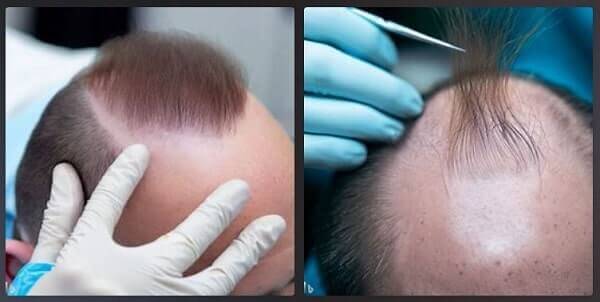Most people never try using extra strength Minoxidil to regrow their hair. Results from high strength prescription Minoxidil will be greater than from using regular store bought 5% Rogaine.
Update: April 27, 2022
Four new interesting items made me update this post.
- During my recent update on online topical Finasteride buying options, I noticed that most vendors were adding higher strength Minoxidil into the mix. Usually ranging from 6-8%.
- Dr. Bhanusali of Hairstim Labs posted an interesting update on Instagram today. He claims that 7% Minoxidil made all the difference in comparison to 6% Minoxidil for one of his patient’s hair regrowth. Note that this doctor is affiliated with Follica, which plans to treat hair loss with Minoxidil and wounding.
- One of the participants in our hair loss chat just posted very impressive before and after hair growth photos of his scalp. He is using a new compounded prescription product from Dr. Powers called “Hair Regrowth Serum V 5.0”. While it contains Minoxidil 8%, it also includes Dutasteride 0.2% and spironolactone 0.25%. So it is hard to tell what portion of the regrowth is due to extra strength Minoxidil alone.
- Dr. Donovan published an interesting article on whether higher concentrations of Minoxidil work better, and the findings are mixed. Minoxidil starts precipitating out of the solution once you go beyond 7 -8% if propylene glycol is the vehicle. For higher strengths, one needs to use other vehicles.
2% and 5% Strength Rogaine
When Minoxidil was first approved by the US FDA to treat hair loss in 1988, it came in a 2% topical solution format under the brand name Rogaine. The product had already been used for many years prior to approval as an off-label hair loss treatment. In 1997, the FDA approved a higher strength version of Minoxidil in the form of a 5% topical solution that could only be obtained via a prescription, although that requirement was soon thereafter waived in 1998.
After Rogaine’s patent ran out, newer generic versions of Minoxidil such as Walmart Equate and Costco Kirkland have come onto the market. More importantly, the topical version (thought still available) has been superseded by a drastically superior foam version. The latter does not run down onto one’s face, sometimes leading to tiny hair growth on the forehead or cause major itching. Note that some people use Minoxidil for beard growth.
I hated using topical Minoxidil, but love using the foam version as it acts like a mild gel and is not as messy. Minoxidil 5% foam has definitely helped my hair. Moreover, within an hour of foam application, I find that my hair feels significantly thicker and fuller. I am certain that this is not a placebo effect. While you are supposed to use Minoxidil twice a day, many people just use it once a day.
Note that Minoxidil is also used by females and women’s 5% Rogaine foam was launched in 2014. Also of significance, Minoxidil still remains one of only two ingredients (the other being Finasteride) that have ever been FDA approved to treat hair loss.
10% and 15% Extra Strength Minoxidil
While 5% Minoxidil was initially considered to be a high strength version of the product, this is no longer true. A number of companies sell 15% (and in some cases, 10% Minoxidil) versions of the product, but I have never tried those. I assume most of these companies will require a prescription before they can sell it to you (and maybe it might even be illegal for them to sell in some countries such as the US).

Minoxidil was originally used as a blood pressure medication. So if you ever use very high strength Minoxidil, make sure you measure your blood pressure regularly. Also keep track of your heart health, since the topical product does get absorbed systemically.
When on Minoxidil 5% to treat hair loss, some people have complained about various side effects such as skin problems, an increase in body hair, water retention and more. Such side effects will probably be exacerbated when on 15% Minoxidil.
Two of the better known companies that currently sell Minoxidil 15% are Xandrox (based in Canada) and MinoxidilMax (brand name Dualgen-15). While the latter has some bad quality pages on its site with missing information, their 10 most popular questions section at the bottom of the home page is worth a read.
Dr. Richard Lee: Minoxidil 15% plus Azelaic Acid
The original extra strength Minoxidil guru was a US-based doctor by the name of Richard Lee. I heard about his name on a regular basis on hair loss forums throughout the 2000-2010 period. He compounded an extremely popular high-strength 15% version of Minoxidil in the 1990s and added azelaic acid to it due to the latter’s anti-DHT (dihydrotestosterone) properties. Update: Azelaic acid also promotes hair growth through the upregulation of Gli1 and Gli2 mRNA and Shh protein.
Since he got an online presence very early on in the internet’s infancy, Dr. Lee’s business took off with a flourish and he had zero competition. However, in 2011, the at-the-time 72-year-old Dr. Lee started having problems with the US FDA and had to close his Regrowth LLC company. Case details here.
Note that another company named Perfect Image Solutions had similar issues with the FDA in 2012 and was forced to cease operations. They were selling a 15% Minoxidil product that also included azelaic acid 5% and Retin-A. One of our chat members said that this product was highly effective for him and he wishes he could find a replacement. Strangely, this Perfect Image Solutions extra strength Minoxidil product still has a detailed review on Amazon.
Getting back to Dr. Richard Lee, check out this video from the old Discovery Channel in which he makes an appearance.
Dr. Oscar Klein: Minoxidil 15% plus Tretinoin (Retin-A)
Another US-based doctor by the name of Dr. Oscar Klein also became extremely popular for selling a reputable extra strength Minoxidil 15% product that also contained Tretinoin (more widely known in the hair loss world by its trade name Retin-A). While Dr. Klein unfortunately passed away in 2014, his Hair Growth MD company still sells his Remox brand products.
A video of Oscar Klein from a 2003 NBC interview:
Even Higher Strength
Polaris Research Labs’ NR-10 product contains 16% Minoxidil. The company’s website does not mention where it is headquartered, but does say that the product is not available for sale in the US. I would try to learn more about this company before considering a purchase.
Update: Per one reader comment, this 16% Minoxidil product is now sold as Follics FR 16 cream and also contains Finasteride, Adenosine and Procapil.
The Medical Wellness Center online pharmacy supposedly offers up to 30% Minoxidil content lotions and creams. Belgravia Centre in the UK offers “extra strength” Minoxidil. Please check with a physician before ordering such products to ensure legality and safety.
You can also go to local compounding pharmacies and they might be able to compound 20% or higher Minoxidil for you. However, this may not be particularly safe for long-term use, and there is a chance that 20% will not be any more effective than 15%.
Also of interest, a 2020 study from Iran found that a combination of minoxidil 20% (plus microneedling) and “carboxytherapy mediated by needling” led to increased hair growth. They call this novel hair growth method Minoxidil Carboxygas.
In the News
Minoxidil has been in the news recently, with companies either: experimenting using it in their main product offering (Follica); or actually using it (RiverTown Therapeutics). Moreover, oral Minoxidil is becoming increasingly popular.
Sometimes it is easy to forget that the combined effect of Finasteride and Minoxidil (see before and after photos) has essentially been a hair loss cure for numerous people. Especially when used in the earlier stages of hair loss.
